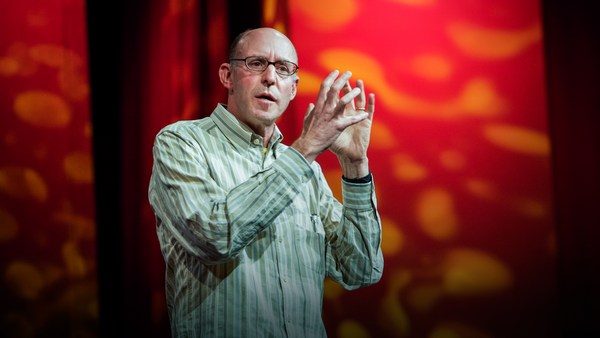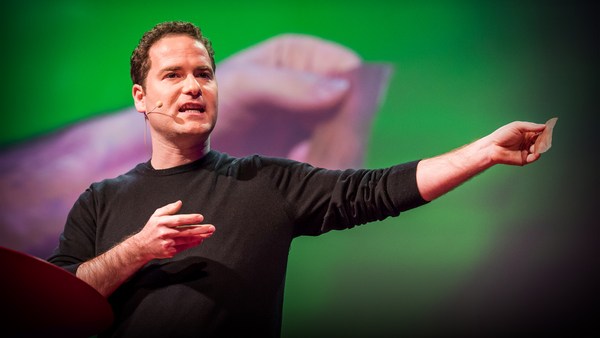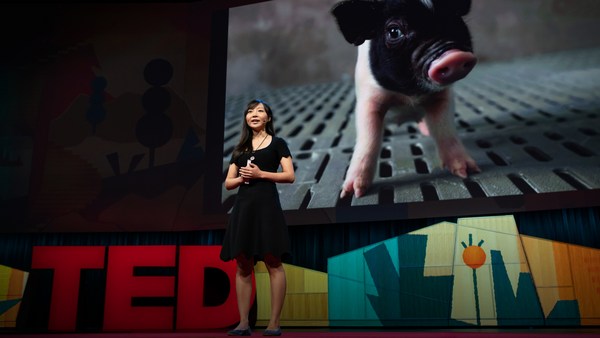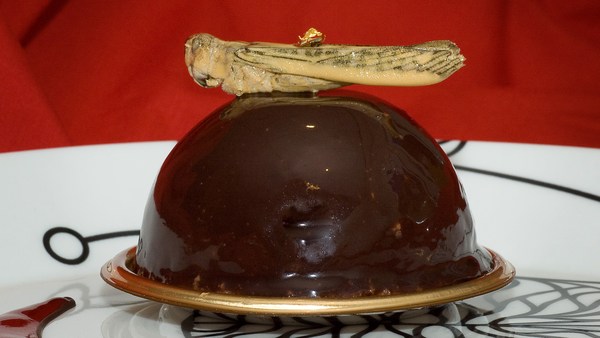Hello. I would like to start my talk with actually two questions, and the first one is: How many people here actually eat pig meat? Please raise your hand -- oh, that's a lot. And how many people have actually seen a live pig producing this meat? In the last year?
In the Netherlands -- where I come from -- you actually never see a pig, which is really strange, because, on a population of 16 million people, we have 12 million pigs. And well, of course, the Dutch can't eat all these pigs. They eat about one-third, and the rest is exported to all kinds of countries in Europe and the rest of the world. A lot goes to the U.K., Germany.
And what I was curious about -- because historically, the whole pig would be used up until the last bit so nothing would be wasted -- and I was curious to find out if this was actually still the case. And I spent about three years researching. And I followed this one pig with number "05049," all the way up until the end and to what products it's made of. And in these years, I met all kinds people like, for instance, farmers and butchers, which seems logical. But I also met aluminum mold makers, ammunition producers and all kinds of people. And what was striking to me is that the farmers actually had no clue what was made of their pigs, but the consumers -- as in us -- had also no idea of the pigs being in all these products.
So what I did is, I took all this research and I made it into a -- well, basically it's a product catalog of this one pig, and it carries a duplicate of his ear tag on the back. And it consists of seven chapters -- the chapters are skin, bones, meat, internal organs, blood, fat and miscellaneous. (Laughter) In total, they weigh 103.7 kilograms. And to show you how often you actually meet part of this pig in a regular day, I want to show you some images of the book.
You probably start the day with a shower. So, in soap, fatty acids made from boiling pork bone fat are used as a hardening agent, but also for giving it a pearl-like effect. Then if you look around you in the bathroom, you see lots more products like shampoo, conditioner, anti-wrinkle cream, body lotion, but also toothpaste. Then, so, before breakfast, you've already met the pig so many times. Then, at breakfast, the pig that I followed, the hairs off the pig or proteins from the hairs off the pig were used as an improver of dough. (Laughter) Well, that's what the producer says: it's "improving the dough, of course." In low-fat butter, or actually in many low-fat products, when you take the fat out, you actually take the taste and the texture out. So what they do is they put gelatin back in, in order to retain the texture.
Well, when you're off to work, under the road or under the buildings that you see, there might very well be cellular concrete, which is a very light kind of concrete that's actually got proteins from bones inside and it's also fully reusable. In the train brakes -- at least in the German train brakes -- there's this part of the brake that's made of bone ash. And in cheesecake and all kinds of desserts, like chocolate mousse, tiramisu, vanilla pudding, everything that's cooled in the supermarket, there's gelatin to make it look good. Fine bone china -- this is a real classic. Of course, the bone in fine-bone china gives it its translucency and also its strength, in order to make these really fine shapes, like this deer.
In interior decorating, the pig's actually quite there. It's used in paint for the texture, but also for the glossiness. In sandpaper, bone glue is actually the glue between the sand and the paper. And then in paintbrushes, hairs are used because, apparently, they're very suitable for making paintbrushes because of their hard-wearing nature.
I was not planning on showing you any meat because, of course, half the book's meat and you probably all know what meats they are. But I didn't want you to miss out on this one, because this, well, it's called "portion-controlled meat cuts." And this is actually sold in the frozen area of the supermarket. And what it is -- it's actually steak. So, this is sold as cow, but what happens when you slaughter a cow -- at least in industrial factory farming -- they have all these little bits of steak left that they can't actually sell as steak, so what they do is they glue them all together with fibrin from pig blood into this really large sausage, then freeze the sausage, cut it in little slices and sell those as steak again. And this also actually happens with tuna and scallops. So, with the steak, you might drink a beer. In the brewing process, there's lots of cloudy elements in the beer, so to get rid of these cloudy elements, what some companies do is they pour the beer through a sort of gelatin sieve in order to get rid of that cloudiness. This actually also goes for wine as well as fruit juice.
There's actually a company in Greece that produces these cigarettes that actually contain hemoglobin from pigs in the filter. And according to them, this creates an artificial lung in the filter. (Laughter) So, this is actually a healthier cigarette. (Laughter) Injectable collagen -- or, since the '70s, collagen from pigs -- has been used for injecting into wrinkles. And the reason for this is that pigs are actually quite close to human beings, so the collagen is as well. Well, this must be the strangest thing I found. This is a bullet coming from a very large ammunition company in the United States.
And while I was making the book, I contacted all the producers of products because I wanted them to send me the real samples and the real specimens. So I sent this company an email saying, "Hello. I'm Christien. I'm doing this research. And can you send me a bullet?" (Laughter) And well, I didn't expect them to even answer my email. But they answered and they said, "Why, thank you for your email. What an interesting story. Are you in anyway related to the Dutch government?" I thought that was really weird, as if the Dutch government sends emails to anyone.
(Laughter)
So, the most beautiful thing I found -- at least what I think is the most beautiful -- in the book, is this heart valve. It's actually a very low-tech and very high-tech product at the same time. The low-tech bit is that it's literally a pig's heart valve mounted in the high-tech bit, which is a memory metal casing. And what happens is this can be implanted into a human heart without open heart surgery. And once it's in the right spot, they remove the outer shell, and the heart valve, well, it gets this shape and at that moment it starts beating, instantly. It's really a sort of magical moment. So this is actually a Dutch company, so I called them up, and I asked, "Can I borrow a heart valve from you?" And the makers of this thing were really enthusiastic. So they were like, "Okay, we'll put it in a jar for you with formalin, and you can borrow it." Great -- and then I didn't hear from them for weeks, so I called, and I asked, "What's going on with the heart valve?" And they said, "Well the director of the company decided not to let you borrow this heart valve, because want his product to be associated with pigs."
(Laughter)
Well, the last product from the book that I'm showing you is renewable energy -- actually, to show that my first question, if pigs are still used up until the last bit, was still true. Well it is, because everything that can't be used for anything else is made into a fuel that can be used as renewable energy source.
In total, I found 185 products. And what they showed me is that, well, firstly, it's at least to say odd that we don't treat these pigs as absolute kings and queens. And the second, is that we actually don't have a clue of what all these products that surround us are made of.
And you might think I'm very fond of pigs, but actually -- well, I am a little bit -- but I'm more fond of raw materials in general. And I think that, in order to take better care of what's behind our products -- so, the livestock, the crops, the plants, the non-renewable materials, but also the people that produce these products -- the first step would actually be to know that they are there.
Thank you very much.
(Applause)





